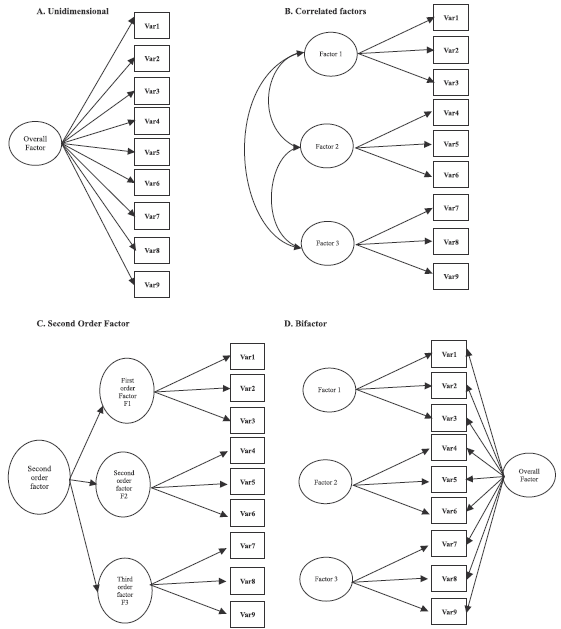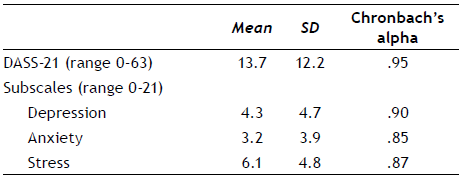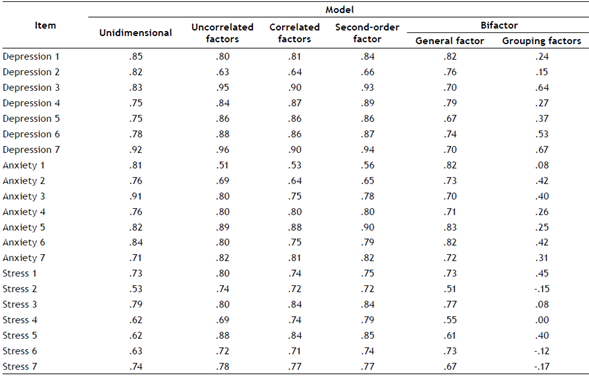According to the World Health Organisation (WHO), globally approximately 1 billion people live with a condition that affects their mental health (WHO Press, 2020). In particular, depression, anxiety, and stress symptoms are frequent among adults and are increasing among adolescents (American Psychological Association, 2020; National Institute of Mental Health Information Resource Center, 2017). In Mexico the prevalence of depression is 9.3% (Arokiasamy et al., 2015) and anxiety is 14.3% (Medina-Mora et al., 2007). Greater prevalence of these conditions has also been reported among specific population groups such as university students (Jiménez-Ortiz et al., 2019), pregnant women (Luna et al., 2020), and in emergency situations such as natural disasters (Maya-Mondragón et al., 2019).
Among the instruments that have been developed to evaluate depression, anxiety, or stress, some allow for a simultaneous assessment of at least two conditions. For example, the Hospital Anxiety and Depression Scale (Buckby et al., 2007), the Mood and Anxiety Symptoms Questionnaire (MASQ; Buckby et al., 2007), the Duke Anxiety-Depression Scale (Parkerson & Broadhead, 1997) and the Patient Health Questionnaire-9 (PHQ-9; Levis et al., 2019) all measure the co-occurrence of depression/anxiety or depression/stress. The Depression, Anxiety, and Stress Scale (DASS) allows for the simultaneous assessment of three conditions (Lovibond & Lovibond, 1995). In its original version, the DASS instrument was used to differentiate the identification of symptoms associated with depression and anxiety, although later studies reported that it could also identify symptoms related to stress (Antony et al., 1998).
There are two versions of the DASS, the 42-item long version (DASS-42) and the 21-item short version (DASS-21). Both have shown adequate psychometric properties with regard to validity and reliability and have been translated into various languages such as Swedish (Alfonsson et al., 2017), German (Bibi et al., 2020) and Portuguese (Vignola & Tucci, 2014). The short version has been validated in Spanish among Spanish and Colombian populations showing adequate psychometric properties (Ruiz et al., 2017). It has been also examined among Ecuadorian university students where internal consistency and factor invariance based on sex were confirmed (Sanmartín et al., 2022).
As for Mexico, several recent studies have used the DASS- 21, especially during COVID-19 pandemic including the general population (Rodríguez-Hernández et al., 2021). DASS- 21 has been also applied among specific subpopulations such as university students (Dosil-Santamaria et al., 2022), schoolteachers (Cortés-Álvarez et al., 2022), and nursing staff in public hospitals (Martínez-Ponce et al., 2023) to report the prevalence of depression, anxiety, and stress and their associated factors. However, and to the best of author knowledge, only one study has explored the factor structure (construct validity) and internal consistency of the DASS-21, using a convenience sample of 200 ambulatory individuals and applying an exploratory factor analysis with varimax rotation (Gurrola-Peña et al., 2006). The authors reported that the best solution had three factors that retained only 14 of the 21 original items of the scale, which explained 42% of the variance observed in the total score. Additionally, Cronbach’s alpha was only reported for the general scale (a = 0.86) but not for subscales, concluding the need for further confirmatory studies (Cortés-Álvarez et al., 2022; Dosil -Santamaria et al., 2022; Martínez-Ponce et al., 2023; Rodríguez-Hernández et al., 2021).
Two recent systematic reviews regarding the DASS (48 and 24 items) have suggested that the instrument exhibited sufficient evidence for its structural validity, internal consistency, and construct validity. Although the measurement of invariance between genders demonstrated inconsistent evidence. Also, there was insufficient evidence for the reliability of each subscale. The analytical tools included main factor analytic approaches, such as: exploratory factor analysis (EFA), confirmatory factor analysis (CFA), one-dimensional factor analysis, multidimensional factor analysis, hierarchical factor analysis, and bifactor model, supporting its original 3-factor structure. The evidence also suggests that bifactor models (consisting of a general factor and three grouping factors) consistently showed the best fit, indicating an underlying unidimensional construct. However, an additional conclusion is that more evidence is needed to determine the best factor structure that adequately describes the properties of the scale (Lee et al., 2019; Yeung et al., 2020). Given the results of previous studies and the lack of evidence regarding the evaluation of the factor structure of the DASS-21 in Mexico, this study aims to determine its factor validity and internal consistency using a non-probabilistic sample of Mexican adults. Our main hypothesis is that the scale could be better described as a unidimensional construct (altered emotional state or psychological distress) with three subscales (related to depression, anxiety, and stress). This structure could be properly approached using the bifactor model.
Method
Study design
This study data stems from a major project titled Behaviours related to movement (physical activity, sleep, and sedentary time) in the Mexican population during the COVID-19 pandemic, with results reported elsewhere (Jáuregui et al., 2022). An online survey of adults aged 18 years and over was used to assess physical activity, screen time, and mental health before and during the lockdown measures established by the federal authorities in Mexico in response to the COVID-19 pandemic. Data collection began two months after the beginning of the voluntary stay-at-home confinement, between May 29th and July 31st, 2020.
Participants
Participants were recruited through the website and institutional social networks of the National Institute of Public Health and the Latin American Congress of Research in Physical Activity and Health. Invitations were posted on Facebook to encourage participation in the study. The final sample was composed of 1,613 Mexican residents (80% female participants, p < 0.001). The study was approved by the Ethics and Research Committees of the National Institute of Public Health (CI-1661) and the participants’ informed consent was retrieved before data collection.
Instruments
The Depression anxiety stress scale -21 items (DASS-21). The DASS-21 Spanish version was used to assess the presence of depressive symptoms, anxiety, and stress in the previous 7 days (Bados et al., 2005). Prior studies have reported high reliability for alpha y omega coefficients related to this scale, both for general factor (a = 0.94, ꞷ = 0.89) and subscales of depression (a = 0.91, ꞷ = 0.91), anxiety (a = 0.88, ꞷ = 0.89), and stress (a = 0.88, ꞷ = 0.89) (Contreras-Mendoza et al., 2021; González-Rivera et al., 2020; Peixoto et al., 2021). The scale is composed of three subscales each with seven items. Responses are encoded on a 4-option Likert scale. Individuals indicate to what extent each statement related to negative emotional states applies to them (0- It does not apply to me at all; 1- It applies to me to a certain extent or sometimes; 2- It applies to me to a considerable degree or a good part of the time; and 3- It applies to me a lot or most of the time). The total score for each subscale ranges from 0 to 21, and higher scores denote higher levels of depression, anxiety, and stress, respectively.
Sociodemographic characteristics
Demographic information was measured, including age (operationalised in decades), sex (female, male), educational level (college or less, bachelor’s degree, and postgraduate), employment status (current paid work), and marital status (single, married/ cohabitation, divorced/widowed). Socioeconomic status was also measured with a validated questionnaire (Nivel Socio Económico AMAI 2018.Nota Metodológica, 2020). This instrument includes items related to household conditions, and the number of inhabitants in order to estimate the socioeconomic level as high, medium, or low.
Statistical analysis
Factor validity of the DASS-21 was determined by comparing 4 models of confirmatory factor analysis and one sub-model: the one-dimensional model (Figure 1, Panel A), the three-factor model (Figure 1, Panel B), the second-order factor model (Figure 1, Panel C), and the bifactor model (Figure 1, Panel D). A brief description of these models is presented below.
The one-dimensional model hypothesises that a single factor explains the variance of all observed variables (items), without discriminating among subgroups of items. The estimated factor loadings would indicate the strength of the relationship between the single factor and each of the observed variables. The multi-factor model (with correlated factors or non-correlated factors) assumes that the observed variables are grouped by shared characteristics, which act as indicators of a hypothesised factor. Here, the factor loadings indicate the strength of the relationship between the observed variables and their associated factor, assuming that there is no general or underlying factor. The second order model explains the shared variance between subordinate factors, meaning that these first-order grouping factors mediate the relationship between the higher factor and the observed variables. In this model there are two types of factor loadings: those that estimate the association between the observed variables and the subordinate factors, and those that show the relationship between the higher order factor and each of the subordinates. Finally, the bifactor model incorporates a general factor, with factor loadings evidencing the association of all observed variables and grouping factors with factor loadings for a subset of the observed variables. Hence, each observed variable has two estimates of its factor load: the first with regard to its relationship with the general factor, and the second with its grouping factor.
The selection of the model with the best fit for the observed data was made by way of standard goodness of fit indices. The Root of the Mean Square Error of Approximation (RMSEA), the Comparative Fit Index (CFI), the Standardised Root Mean Square Residual (SRMR) were considered, using the cut-off points recommended in the statistical literature (Tabachnick & Tabachnick, 2014); as well as the Akaike (AIC), Bayesian (BIC), and adjusted sample size Bayesian (aBIC) information criteria (Brown, 2015). The internal consistency of the DASS-21 and its subscales was evaluated by means of Cronbach’s alpha (Cronbach, 1951). The value of the chi-square test and the associated p-values are also reported for each model, although this test is of little use since it is very sensitive when the sample size is large (Schermelleh-Engel et al., 2003).
Models for confirmatory factor analysis were estimated in Mplus v8.5 using the maximum likelihood estimation and robust standard errors to address non-normality of the DASS-21 scores and their subscales. To avoid local maxima for the EM (expectation-maximisation) algorithm, models with 200 random starting values and 100 iterations per set of start values were estimated (Muthén & Muthén, 1998)
Results
The study sample consisted of 1 613 participants whose sociodemographic characteristics are summarised on Table 1. Among the participants 80% were women, 74% were under 40 years of age, 76% had a paid-work, 37% were married or in cohabitation, 2.4% were classified as having a low socioeconomic level, and 72% had university level or higher education.
Table 1 Sociodemographic characteristics of study participants.
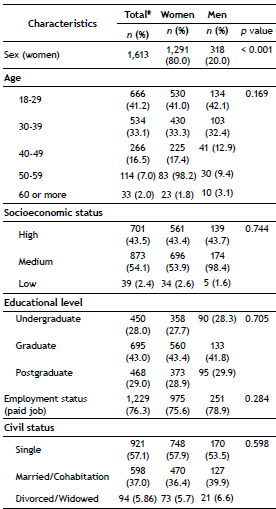
Note. * = 4 participants preferred not to answer regarding their sex. p values were obtained with Pearson’s chi2 tests.
Descriptive statistics for the DASS-21 scale with its three subscales, as well as internal consistency data are shown on Table 2. The values for the general scale (a = 0.95) and the depression subscale (a = .90) resulted in excellent reliability, while for the anxiety (a = 0.85) and stress (a = 0.87) subscales the values showed acceptable levels.
Measures of goodness of fit and average factor loadings are shown on Table 3. For overall goodness of fit measures (RMSEA, CFI, and SRMR) the bifactor model showed appropriate values (0.06, 0.98, and 0.03, respectively). The AIC, BIC and aBIC criteria also showed that the bifactor model had the best fit to the observed data given that it had the lowest values for the three selected criteria (55125.92, 55695.89, and 55362.32, respectively).
Table 3 Goodness of fit statistics and factorial loadings of the DASS-21 scale.
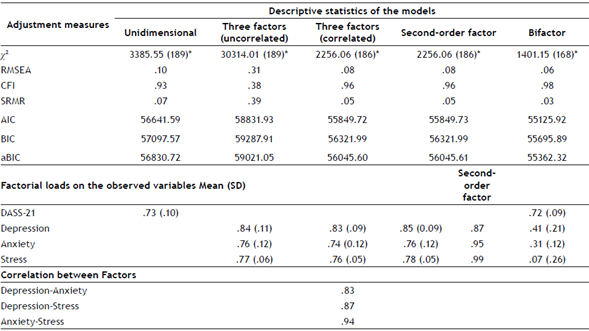
Note: χ2 = Chi-square (degrees of freedom); * = p < 0.01, RMSEA = Root of the mean square approximation error; IFC = Comparative Adjustment Index; SRMR = Standardised Root Mean Square Residual; AIC = Aikaike Information Criteria; BIC = Bayesian Information Criterion; aBIC = Adjusted Bayesian Information Criterion; SD = standard deviation.
Regarding factor loadings, the average load in the bifactor model was 0.72, which implies that the overall factor explains 72%, on average, of the variance of the observed variables. This high average load indicates that a significant measurement of the construct in question is being carried out (Tabachnick & Tabachnick, 2014). Additionally, the range of mean factor loadings of clustering factors (0.07 to 0.41) is evidence of the multidimensional nature of the DASS-21 by incorporating the constructs of depression, anxiety, and stress. The detailed list of factor loadings is summarised on Table 4.
Discussion
The objective of this study was to determine the factor validity and internal consistency of the DASS-21 scale in a non-probabilistic sample of Mexican adults. The bifactor showed better fit to the observed data. Therefore, the application of the bifactor model to the DASS-21 supports its validity in identifying symptoms of depression, anxiety, and stress (associated with three specific factors), as well as an altered emotional state (associated with a general factor) for the population of Mexican adults.
The findings of the present study regarding the validity of the factor structure of the DASS-21 are in line with previous studies. A study using the English version of the DASS-21 among psychotherapy students and patients aged >18 years in Sweden identified that the bifactor model had the best adjustment rates for a structure of three specific factors (associated with depression, anxiety, and stress), and a general factor associated with an affected emotional state (Alfonsson et al., 2017). Another study carried out in eight countries (Brazil, Canada, Hong Kong, Romania, Taiwan, Turkey, United Arab Emirates, and the United States) using local language versions of the DASS-21 among 2,580 university students, also reported that the bifactor model, with depression, anxiety, and stress as specific factors and general distress as general factor presented the best fit within each country. (Zanon et al., 2021). Finally, systematic reviews including both the long version DASS-42, and the short version DASS-21 (Lee et al., 2019; Yeung et al., 2020), support that the bifactor model was the one that consistently showed the best fit, supporting an underlying general construct and a structure of three specific factors.
For the Spanish version, our results are also consistent with previous findings. A study among 2,980 university students from Colombia and Spain compared three different models (one-dimensional, correlated factors, and second-order factor), showing that the second-order factor model had the best fit rates (García et al., 2017). It is important to note, that the second order factor should not be interpreted as a general factor that explains the variance of the observed variables. Instead, this second-order factor explicitly models the shared variance between subordinate factors. In terms of the DASS-21, this model suggests that there are three specific factors (depression, anxiety, and stress subscales) and that the higher-order factor is a good measure of the sum of the three subscales. The substantial difference with respect to the bifactor model is that it allows the estimation of a general factor whose score can be interpreted as a general emotional state. It is important to note that these results do not represent evidence regarding the factor validity of the DASS-21 given the exploratory nature of the analysis. Another study among 200 Mexican adults between 20 and 60 years of age conducted an exploratory factor analysis to determine the factor structure of the DASS-21 (Gurrola-Peña et al., 2006). The results evidenced that a solution with three factors was appropriate, according to the fit indices, and that these factors could be interpreted as the subscales originally proposed: depression, anxiety, and stress. Additionally, the authors of this study reported similar levels of the alpha reliability coefficient for each subscale (.79, .78, .76, respectively) although of lower magnitude than those recorded in the present study. Finally, another study conducted in Ecuador with 3,060 university students using the DASS-21 version, found that the three-factor structure of the scale was empirically verified according to the results of a confirmatory factor analysis, and concluded that it was invariant between males and females (Sanmartín et al., 2022).
The present study has limitations that need consideration. First, the results presented should be interpreted with caution as they refer only to the DASS-21 factor validity. Other components such as concurrent validity or predictive validity could not be evaluated because the study from which our data is derived did not collect information on the same disorders (depression, anxiety, stress) with other instruments, or on potential outcomes associated with such disorders such as mortality or disability (García et al., 2017). Second, although it is a large sample among respondents from several regions of Mexico, it is not a probabilistic sample; therefore, the results are confined to our study sample. Third, in our study it was not possible to analyse the scale invariance (by sex or age) due to sample imbalance, 80% were women and only 2% were older adults.
Conclusion
The results of the present study provide novel and objective evidence regarding the validity of the DASS-21 for application among the Mexican population. Results shown that DASS-21 can be used to assess the presence of symptoms associated with depression, anxiety, and stress, as well as an altered general emotional state. The findings of this study suggest that the DASS-21 is a theoretically sound instrument that is useful in both research and clinical practice. The DASS-21 can be an accessible tool for clinicians, psychologists, and researchers in the public health and education field for identifying individuals with psychological alterations in mental health primary care, and for estimating the magnitude of these alterations on the level of the general population1 2.














